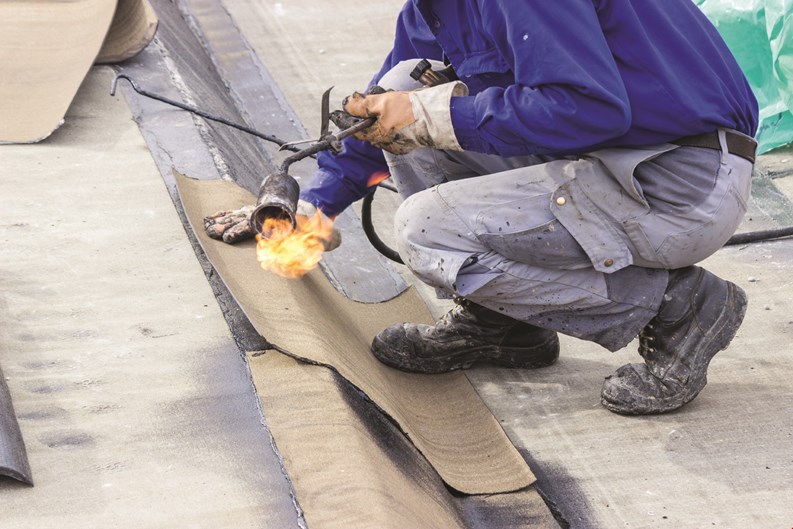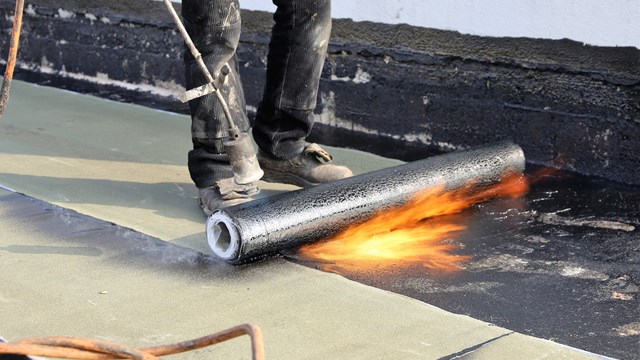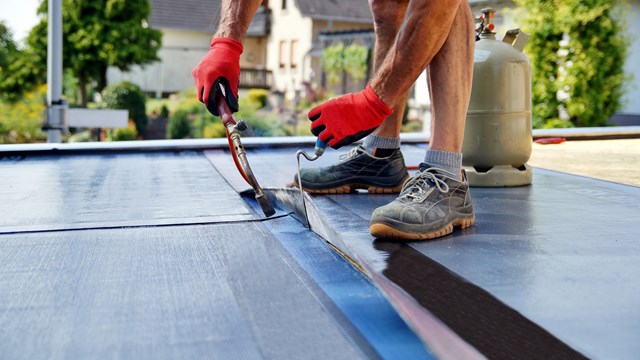A building’s roof serves as the first line of defense against whatever the skies throw at its inhabitants—wind, rain and blazing sun, even snow and ice in some climates—so it’s crucial for that roof to be sound and well maintained. All it takes is one small crack or hole for the rainwater to get in and, poof! There goes thousands of dollars in repair and potential insurance claims (not to mention the damage it can cause to residents' possessions and property). Knowing how to maintain and repair what's on top of your buildings can ultimately protect its bottom line.
What's Up There?
According to James R. Kirby, AIA, the director of technical services for the national Asphalt Roofing Manufacturers Association (ARMA) in Washington, D.C., the most common types of roofs in dense urban areas are 'low-slope' or flat roofs. “The roof types include asphalt-based roof systems, called built-up and modified bitumen, and single-ply roof systems,” he says.
“The building designer most commonly determines if a rooftop is steep-slope (pitched) or low-slope (flat),” says Kirby. “Most tall buildings have low-slope roofs because the roof is not a visible architectural element. Low-slope roof systems include a roof deck (which in this context is the base layer upon which the other roofing materials sit—not a recreational common area), a vapor barrier if needed, at least two layers of insulation, a cover board, a membrane, and some type of surfacing.”
The majority of residential roofs in New Jersey are either “flat” roofs or pitched roofs. “You're talking asphalt shingle in the 80 percent range, if not more. A lot of contractors are using asphalt now, because they're so reliable,” says Barry Scymanski, general manager of Alpine Roofing in Sparta.
Historic areas can cause restrictions on what roof contractors have to build, for the sake of a block or neighborhood's architectural continuity. “Sometimes you get a condo being built, sometimes they're being built in a historical district, you're not going to see the asphalt shingle as much. You're going to go to a historical product like slate, or metal,” says Scymanski.
How long a roof lasts will depend on what it’s made of and how it’s maintained. “Shingles will typically last 30 years, while an average flat system lasts 15 years,” says Chuck Goss, president and founder of P. Cooper Roofing, Inc., in Trenton. “Different manufacturers offer different premium material with higher warranties at very high premium prices.”
Vulnerable Points
No matter how durable the materials or how well they were installed, at some point a roof will begin to deteriorate under stress from the elements. Sections can begin to break down, allowing moisture to seep in and cause damage. The most vulnerable parts of a roof are at the perimeters and at penetration points, such as vents, skylights, and water tank footings.
“At penetrations, the roof membrane transitions from horizontal to vertical,” says Kirby. “A flashing is used so the roof remains weatherproof at penetrations. At perimeters, a roof system will transition to a parapet wall, or will remain horizontal and transition to some type of edge metal; both require flashing to remain weatherproof.”
Gil Stein, owner of Hercules Roofing LLC in Boca Raton, FL, says that as a roof gets older, it typically begins to have problems where it meets that parapet wall. “That’s the most typical area for a leak in a roof,” he says. “If the flat roof is not maintained, there could be protrusions and problems around plumbing stacks, exhaust fans and HVAC equipment that isn’t properly maintained. If these areas are not resealed, they allow water to seep in.”
On shingled roofs, Goss says that overflowing gutters cause damage to the soffit and fascia wood, which in turn leads to leaks. “We also see leaks from the roof penetrations, poor flashing, and so forth, but the number one source of leaks on flat roofs is damaged or clogged roof drains. If the roof has build-up around the perimeter, four, five, even six inches of water can back up on the roof causing leaks, or worse—including structural damage from the weight of the water itself.”
Buildings that have usable rooftops, such as sun decks or other recreational common spaces, have their own set of problems. “Typical maintenance concerns include penetrations in the roof membrane when the deck is installed, as well as furniture, BBQ equipment, plants, and so forth that may have sharp edges that can puncture the roof membrane,” says Goss.
Buildings with recreational spaces on their roofs should have those elements checked more often. Despite their longevity and seeming durability, roofs can be delicate. “It’s not unheard of to have leaks result from a contractor going up on the roof and dropping their tool belt or knife and it cuts a hole,” says Stein.
And even though this past winter was pretty mild for most of the country (as of this writing anyway), climate plays a huge role into the length of a roof's life span—but it’s not just about how many inches of rain fall, or how hot the summer is.
“Climate is a huge impact, so roofers in different regions adjust their materials to weather the climate of the area,” says Goss. “Sun dries out the oils in the material, and ice will cause the material to crack. Even an abrupt temperature change can create what's called 'thermo-shock.' That typically happens when temps change 30 to 35 degrees in a 24-hour period.”
Roof Inspections
After a certain number of miles driven, you change the oil in your car, rotate your tires and change your fluids. The same concept should be applied to the maintenance of the roof. “The National Roofing Contractors Association (NRCA) guidelines traditionally suggest inspecting your roof in the spring and in the fall,” says Matthew Baker, salesman at Raincoat Roofing Systems, Inc. in Broadview, IL. “Most warranties say at least once a year, and that inspection would happen in the fall.”
And it's not really enough just to have your superintendent or building maintenance person go up and give the roof a quick once-over. These inspections should be conducted by a professional roofing contractor who is able to see small problems before they become dangerous or expensive. “Every roof inspection is different,” says Kirby. “Observing the underside of the roof deck (again, not the one with the chaise lounges on it—the one that underpins the rest of the roofing layers) is important, as it may show signs of distress and lead an inspector to investigate specific locations more closely from the topside. An inspector will walk the roof’s perimeter, observe every penetration and flashing on the rooftop, then walk the field of the roof.”
The key points of a fall or spring inspection follow the most common causes of roof failure. “We start by making sure the drains are clear, then inspect the base flashing of the roof penetrations, inspect the roof edge metal, then on flat roofs, inspect the membrane seams. On the shingle roofs we look for any missing or damaged shingles,” says Goss. “Also, the pipe collar flashing should be checked in detail to see if it is starting to crack or wear.”
Baker says that on his inspections, he looks up. “You need to look at the ceilings, where you can see where water infiltration issues are, or where there were problems in the past,” he says. “Also, look at how much debris is on the roof. Generally, if it’s a housekeeping mess, you know that the maintenance staff and property manager do not really take care of the roof. Our objective is to try and maximize the lifespan of the roof. There are times you can fix it, but there are times that you have to be upfront with the customer that it’s time for replacement. The rule is that if you are spending more than 5 to 7 percent of replacement cost on repairs in a given calendar year, you should be considering a replacement.”
The cost of an inspection depends on the size of the building and ease of access, as well as how detailed the report has to be. “The price can range from $700 to $3,000,” says Goss.
Building Staff
So, in-depth roof inspections should be done by a qualified specialist. But are there any roof problems that can be handled by a building staff member? That depends. “The maintenance is going to depend on the warranty, but the only one who should be working on the roof is someone who is certified to work on that system,” says Baker. “If you go up and are not a roofer, you can end up using tools or materials that aren’t compatible with the system you have. That can lead to additional costs, and even catastrophic failure.”
That said, your building's maintenance staff can handle some smaller roof-related responsibilities, including removing debris that can cause latent damage, like leaves, branches and bottles that can puncture the roof membrane or cause deterioration by allowing moisture to pool or seep into the surface.
“They should regularly examine masonry and metal work for signs of deterioration or water infiltration,” says Kirby. “Another way to maintain a roof is to make sure that rooftop equipment is in proper working condition and, where necessary, piped to drainage. Lastly, minimizing unnecessary foot traffic on the roof will help avoid potential damage. That means keeping access doors locked, and requiring any rooftop visitors and workers to sign in or be escorted.”
A maintenance staff member can also do a walkthrough of the roof to check for obvious problems. That includes “looking for holes—or if you walk and feel air or water bubbles underneath your feet,” says Stein.
Depending on location, roofs and drains need to be cleaned between two and four times a year. “This can also be done by maintenance staff with OSHA fall protection knowledge,” says Goss.
Beyond those basics, only professional roofing contractors should perform maintenance and repairs. Those contractors will work with the roof system manufacturers to ensure that repairs and warranty issues are dealt with appropriately.
“Roofs are not indestructible, and should be treated with respect,” says Kirby. “Appropriately constructed roof decks, and the use of walkway pads and protection layers are necessary if residents expect to use a roof and for that roof to last. The best advice is to stay off the roof; reduce foot traffic; don’t use a roof as a work or play platform.”
Lisa Iannucci is a freelance writer and a frequent contributor to The New Jersey Cooperator.







Leave a Comment